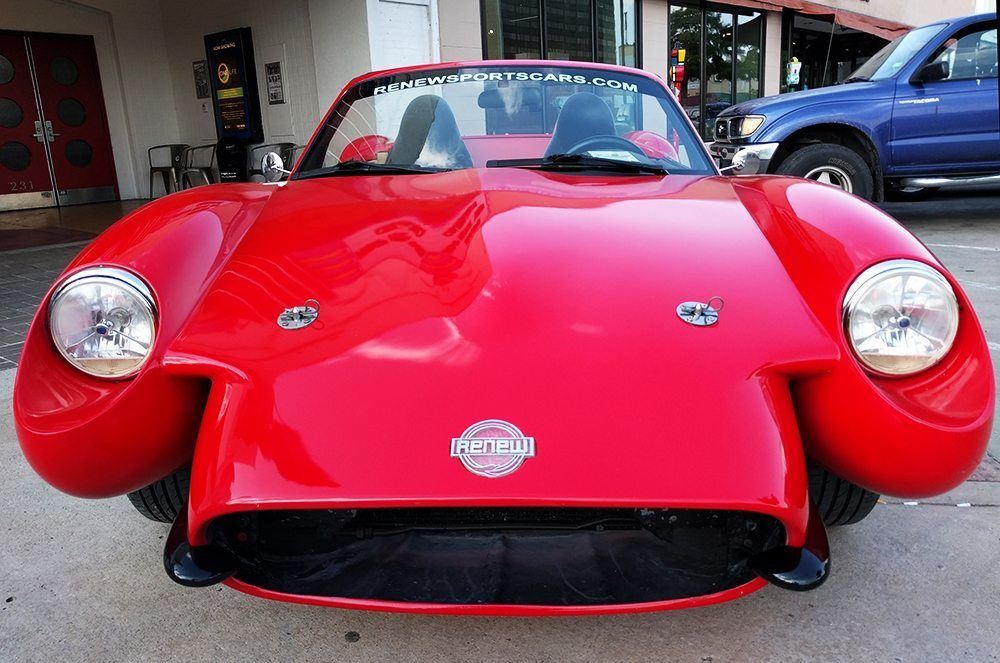[ad_1]
Ministry of Hemp talks with Bruce Michael Dietzen, founder of Renew Sports Cars – the startup that created the Cannabis Car.

But first, here is a bit of history. The original Hemp Car was introduced by Henry Ford back in 1941. This car was made from hemp, soy, flax wheat straw and ramie, and powered by hemp fuel made from the agricultural waste. Henry Ford was a hemp farmer, just like George Washington and Thomas Jefferson, and he was inspired to create the car not out of a concern about the environment, but to help struggling American farmers. Through this effort, Ford inadvertently almost paved the way for sustainable, carbon neutral cars. Yet, his discovery laid hidden for over 75 years.
Bruce talks about “Renew-ing” Ford’s vision and the benefits which hemp-based vehicles will bring.
Let’s start from the beginning. How did you first get introduced to hemp?
Bruce Dietzen: It was quite by accident actually. I had already begun the process of designing a car inspired by numerous European race cars from the 1950s. Back in those days, while American designers thought rocket ships were sexy, Europeans designers thought the only thing that was sexy was the voluptuous curves of a woman. In my humble opinion, they were right then, and that design maxim still holds true today. So I was simply designing a sexy car.
So what happened then?
“I knew I had to follow in Henry Ford’s footsteps.”
BD: That’s when someone told me “If you want something beyond just sexy and truly world changing, check out what Henry Ford did with his hemp car.” So I did. As it turns out, Ford spent 12 years, from 1929 to 1941, planning to make and fuel all future Ford Motor vehicles from plants like cannabis hemp.

He actually made a car with hemp?
BD: Yes. To draw a comparison, Henry Ford was the Steve Jobs of his day. He was always thinking years ahead. So I was compelled to look into his supposed hemp car in depth. And with some help from my new found friend Brandon Pitcher of Hemp Circle Industries and his network of analysts, we calculated just how green Henry Ford’s prototype hemp car really. Frankly, we were shocked with what we found.
What did you find?
BD: Henry Ford had discovered how to make cars from hemp that were four times greener than today’s electric vehicles, almost 75 years ago. That’s when I knew I had to follow in Henry Ford’s footsteps.
Four times greener? Most people assume that electric cars are the ultimate green solution. How is that possible?
BD: A Union of Concerned Scientists study recently concluded that the Lifetime Carbon Footprint (LCF) of today’s electric vehicles are about half that of gasoline cars. Unfortunately, they forgot to factor in that electric vehicles need a second set of lithium ion batteries in order to reach today’s average Vehicle Miles Traveled of 227,200 miles. Once, you factor a second set of batteries in, electric vehicles have an Lifetime Carbon Footprint that’s 66% of gas cars.
How does Henry Ford’s Hemp Car stack up against that?
BD: By making every component he possibly could from carbon negative plants like hemp, Ford offset the other carbon positive components. As a result, he effectively negated the CO2 generated during the manufacturing process which is usually about 23% of an internal combustion vehicle’s Life Carbon Footprint. He then fueled his car with cellulosic ethanol made from hemp remnants, which today is considered a second generation biofuel and 86% greener than gasoline. So the math was simple from there. Electric vehicles s have a footprint that’s 66% of gas cars, while Ford’s hemp car had a footprint that was 14% of gas cars. That’s a pretty big difference.
4.7 times greener. I get it. So what are the implications?
BD: Electric Vehicles aren’t going to save the planet but Ford’s vision could. The world’s fleet of cars and trucks is projected to increase by 2.5 times by 2050. Just to hold steady with the total CO2 they generate today, 100% of cars would have to be electric (of which only 50% are projected), and their footprint would have to drop from 66% of gas cars to 40%. That’s not going to be easy considering that the aluminum, lithium and petro-plastics used to make electric vehicles are intensely carbon positive, and the electricity used to charge electric vehicles will still be highly fossil fuel dependent for decades to come due to increased demand for more electricity.
By contrast, let’s envision today’s existing cars and trucks running on a biofuel that’s compatible with today’s liquid fuel infrastructure. Something like cellulosic Biobutanol. This is not only possible to do with minor modifications to existing engines, but the entire infrastructure required to produce these types of fuels right here in the States would cost less than the cost to build the F35 fighter jet. And the amount of CO2 which our vehicles add to the environment would be cut by 87% within a decade.
That’s quite a contrast. But you believe we could take a step beyond that right? Your vehicles could actually help reverse climate change?
“It’s now possible to create carbon negative fuels which are 100% compatible with the gas powered cars on the road today.”
BD: Yes. Again, by using agricultural waste, apparently it’s now possible to create carbon negative fuels which are 100% compatible with the gas powered cars on the road today. This type of fuel is carbon negative because it yields a byproduct called biochar which gets plowed back into agricultural soils. So some of the CO2 which plants pull out of the environment gets recycled, and some of it gets buried or “sequestered.” Using these types of fuels, we can actually help reverse climate change with every mile we travel.
And the agricultural waste from hemp plants can be used to make carbon negative fuels?
BD: Yes, as well as any other type of agricultural waste or yard trimmings.
You were a National Sales Manager at Dell, effectively retired, and had moved to Florida. You could’ve just kicked back and enjoyed retirement. What motivated you to launch this startup?
BD: I didn’t want to look back at the end of my life on this little blue ball and think “Wow, I sold a lot of computers.” I saw an opportunity to help save the planet and I took it.
Why use hemp in particular?
“Body panels and chassis components made from hemp are lighter weight than steel or metal, and are are far more dent resistant than steel. Every bit of plastic, carpeting and upholstery in a car can be made of hemp.”
BD: For car production, nothing beats hemp. Body panels and chassis components made from hemp are lighter weight than steel or metal, and are are far more dent resistant than steel. Every bit of plastic, carpeting and upholstery in a car can be made of hemp. So as I mentioned earlier, all of these components, when made from carbon negative hemp instead of carbon positive materials can reduce the lifetime carbon footprint of cars by up to 23%.
There are other plants we could use of course, but hemp grows faster than just about any other plant that can be used to make products. It needs far less fertilizer, insecticides and water. Its yield is higher and it’s actually good for the soil. It not only produces some of the strongest fiber in nature, but also produces very nutritious seeds as well as something called Cannabidiol which is being used to treat dozens of illnesses from Epilepsy to Alzheimers to Cancer. It’s the most versatile and beneficial planet on Earth.
So Henry Ford made the original hemp car back in 1941, but it never commercialized. Why do you think it never did?
BD: Oh it would have. And we all would likely be driving Cannabis Cars today if it weren’t for World War II. Ford had been working on his cannabis car for 12 years. In his mind, all vehicles would be made and fueled by plants in the future. But only months after debuting his car, President FDR, who was on a mission to “War Time Mobilize” the country, visited Ford in Dearborn and convinced him to stop making cars and make bombers instead. So for the duration of the war, that’s exactly what Ford did. During that period, Mr. Ford suffered several strokes, and then passed away shortly after the war ended. Several years later, his hemp prototype was destroyed for some undocumented reason, and Henry Ford’s greatest achievement was nearly lost to history.
It’s a fascinating story. In fact, we plan to make an episode in an upcoming Docu-series that does just that. So here’s the bottom line. Ford helped win the war, but he could have saved the planet.
So, do you think Henry Ford’s vision will ever come to fruition?
BD: Absolutely. In my humble opinion, we have no other choice than to adopt his vision and ‘War Time Mobilize’ once again. Because the war against climate change is the going to be the most important war humanity has ever faced.
“We have no other choice than to adopt his vision.”
Climatologists are now saying that we need to take dramatic measures beyond simply banning fossil fuels. We need to be actively sequestering CO2 from the atmosphere. One of the most effective ways that we will hopefully be doing this in the near future is by making our durable goods, our vehicles and our fuels from carbon negative plants like hemp.
Do you think a car like this can become commercially viable? If so, what do you envision the price point to be?

What do you see as the biggest challenge/obstacle to get to that vision?
BD: The biggest challenge right now is financing individual car purchases. We get a lot of interest in the car, but most folks don’t have 40 thousand in cash. So we need to sell the first 20 cars or so for cash, establishing a value for these cars in the market. At that point, the financing companies will be more willing to finance or lease these vehicles.
This is one of those innovations that could truly change the fundamental landscape of the transportation/auto industry. How could the public support you?
BD: Folks can not only support Renew Sports Cars, but all the emerging companies making hemp products. Simply googling ‘hemp’ and buying hemp products can help grow the hemp industry. Every time they buy a hemp product, they not only support hemp related businesses, but they help save the planet.
We’d love to learn more about the Cannabis car you built.
BD: The best way to do that I suppose is to visit the Renew Sports Cars web site.
So, what’s next for you & Renew Sports Cars?
BD: The next thing we plan to do is build a few high performance versions of this car. One may be electric, and another one will have a 640 horsepower internal combustion engine capable of running on either gas or even 100% second and third generation biofuels. At roughly 2,900 pounds, it will have a power to weight ratio comparable to supercars in the half million dollar range, at less than half the price. I’m hoping that is going to get us on the cover of Car and Driver. I’d like to see that!

Thanks for your time today Bruce. We love the work you’re doing for hemp and look forward to seeing many more hemp cars in the future!
[ad_2]
Source link